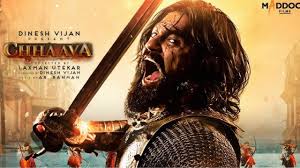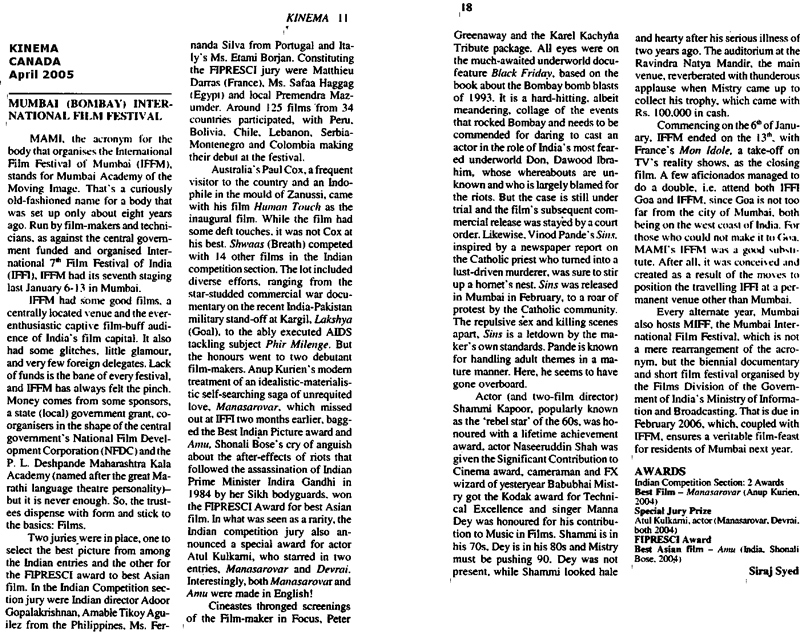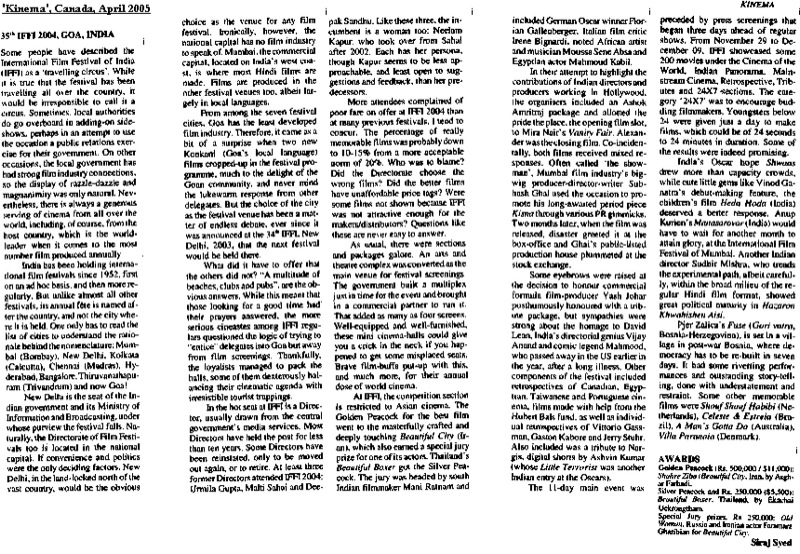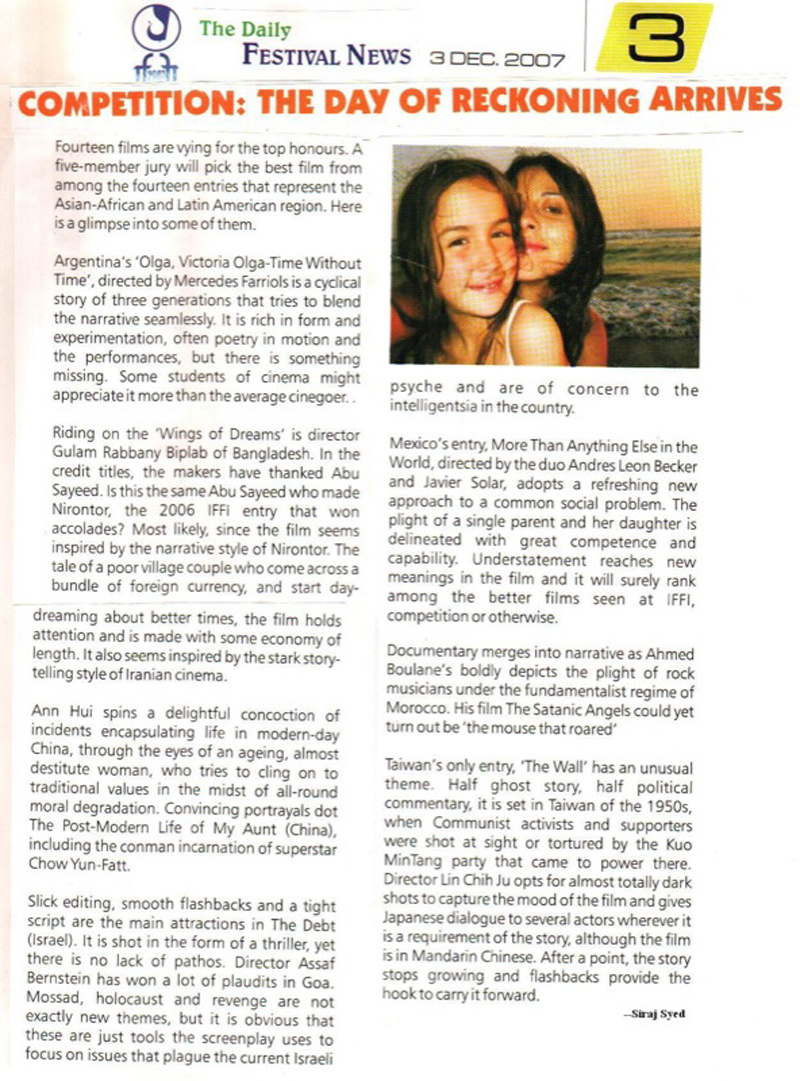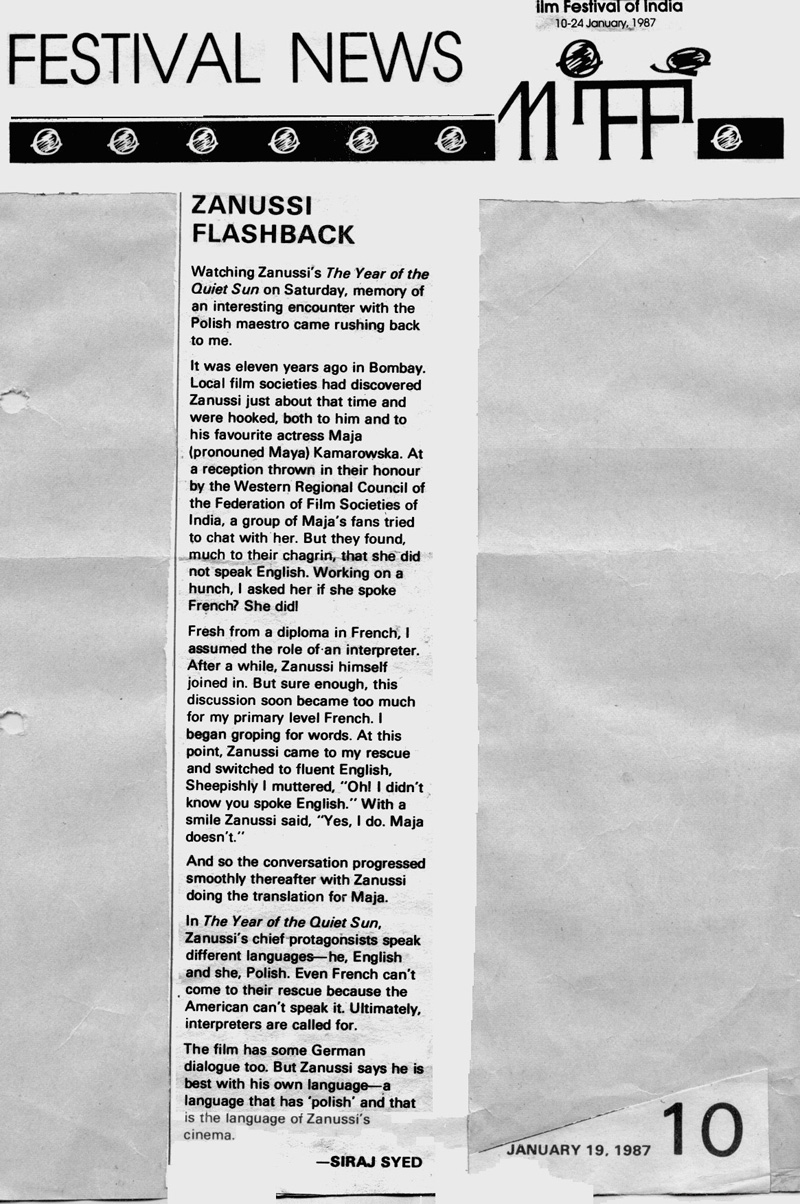|
|
||
|
Pro Tools
FILMFESTIVALS | 24/7 world wide coverageWelcome ! Enjoy the best of both worlds: Film & Festival News, exploring the best of the film festivals community. Launched in 1995, relentlessly connecting films to festivals, documenting and promoting festivals worldwide. Working on an upgrade soon. For collaboration, editorial contributions, or publicity, please send us an email here. User login |
Chhava, Review: Vicky Kaushal has arrived, and how!
Chhava, Review: Vicky Kaushal has arrived, and how! A new word for many cine-goers, Chhava means a lion’s cub or an elephant’s young one. It was an epithet given to Chhatrapati Sambhaji, son of Chhatrapati Shivaji Maharaj, Chhatrapati Shivaji Maharaj, as the lion, and his son, Chhatrapati Sambhaji Maharaj, as the cub, to symbolise his valour and legacy. It also means boss. A film, based on Sambhaji’s life, has just been released, with the title, Chhava. It comes as part of the spate of films highlighting India’s patriotic strength, and projecting the Moghuls and other Muslim invaders, as despots and tyrants, who propagated the spread of Islam at sword-point. After a long disclaimer and Ajay Devgn’s voice over, the story of Sambhaji unfolds. It is not a biopic, as it confines itself to a short period in Sambhaji’s life, when he battled the Mughal king, Aurangzeb. Since history is not written in screenplay style, Chhava takes creative liberties in depicting personal and family scenes, and giving the performers dialogues to mouth. Made on a grand scale, Chhava has intense performances and superbly shot battle scenes. Yet, it gives us more of the same very often, and loses its way in last quarter of the footage. Let us check what history tells us about Shivaji, Sambhaji and Aurangzeb. “Shivaji descended from a line of prominent nobles. India, at the time of his birth, in 1630, was under Muslim rule: The Mughals in the north, and the Muslim sultans of Bijapur and Golconda in the south. Shivaji, whose ancestral estates were situated in the Deccan, in the realm of the Bijapur sultans, found the Muslim oppression and religious persecution of the Hindus so intolerable that, by the time he was 16, he convinced himself that he was the divinely appointed instrument of the cause of Hindu freedom. He propounded the theory of Hindavi Svarajya (self-rule of Hindu people). In the summer of 1674, Shivaji had himself enthroned as an independent sovereign. His coronation marked the formal beginning of the Maratha empire. His kingdom’s security was based on religious tolerance. Shivaji breathed new life into a people that for centuries had resigned itself to serfdom and led them against Aurangzeb, a powerful Mughal ruler. Shivaji died in 1680.” “Aurangzeb (Muhi al-Din Muhammad) was the son of Mughal Emperor ShahJahaan, being the sixth Mughal emperor, reigning from 1658, until his death, in 1707, at the age of 88. Under his reign, the Mughal Empire reached its greatest extent, with territory spanning nearly the entirety of the Indian subcontinent. Dara Shikoh, Aurangzeb’s elder brother, was designated by their father as his successor to the throne, on which Aurangzeb had his eyes. Decisively defeating Dara in 1658, he confined his father in his own palace, at Agra, for 8 years. Aurangzeb applied his great-grandfather Akbar’s technique, for conquest: defeat one’s enemies, reconcile them, and place them in imperial service. Thus, Shivaji was defeated, called to Agra for reconciliation (1666), and given an imperial rank. However, Shivaji escaped, and fled to the Deccan, where he died, in 1680, as the ruler of an independent Maratha kingdom. The Deccan kingdoms of Bijapur and Golconda were conquered by Aurangzeb in 1686–87. He ruled for 47 years.” “Upon Shivaji’s death, he was succeeded on the throne by his son Sambhaji (Sambhajiraje Shivajiraje Bhonsle, also known as Shambhuraje) in 1680. Sambhaji was entangled in a bitter accession struggle with his half-brother Rajaram, who was 10 at the time. Soyrabai, Sambhaji’s stepmother and the mother of Rajaram, plotted against to keep him away from the throne. Ultimately though, Sambhaji gained the support of Maratha commander-in-chief Hambirrao Mohite and, in January 1681, was officially crowned ruler of the Marathas. Sambhaji plundered and ravaged Burhanpur (in present-day Madhya Pradesh), in 1680. His forces completely routed the Mughal garrison and punitively executed captives. The Marathas then looted the city and set its ports ablaze. Sambhaji was king, for nine years, until 1689, when he was ambushed, captured, tortured and executed, along with his dear companion, Kavi Kalash, by Aurangzeb. Aurangzeb also captured Sambhaji’s son Shahu, and Sambhaji’s half-brother Rajaram thus ascended the throne.” Writing a film like Chhava means writing or rewriting history, endorsing or denying versions recorded by historians of the past, who often differ on what actually happened. It is based on the book, Chhava, by Shivaji Sawant. For the film, scripting credits go to director Laxman Utekar, Rishi Virmani, Kaustubh Savarkar, Unman Bankar and Omkar Mahajan. Dialogues come from the pens of Rishi Virmani and Irshad Kamil, the lyricist, whose services would have taken care of the Urdu language, often used in the film, by the Mughals. Limiting itself to Sambhaji’s attack on Burhanpur and his final battles against Aurangzeb nine years later, the narrative detours twice, once to highlight the role of Soyrabai and the efforts of Aurangzeb’s son Akbar to usurp his father’s throne. A passing diversion is the exchange of pleasantries between Sambhaji and a British military official, where Sambhaji speaks a bit of correct English. For the rest, the film sticks to its core. A historical war film is a field day for writers and directors to decorate the plot with scenes of gory-gruesome-grisly-blood curdling battles, earth shattering and ear-splitting war cries, extravagant royalty, grandeur, palace politics, secret plotting, espionage, loyalty, betrayals, patriotic poetry, slogans, war cries, religious incantations, regal romances, and so on. All of them are found in Chhava, in good measure. If anything, the war scenes are over the top. In an impressive introduction, Sambhaji is seen on horse-back, leading his troops in battle, in the attack on Burhanpur. In many Indian films of the last few decades, the villain is introduced emerging from a car, with the camera starting from an extreme low angle, at the shoes of the bad guy, and slowly moving upward, to reveal his full self, face last. Director Laxman Utekar uses this ploy to introduce his Chhava, from his horse’s hooves to the rider. What follows are incredible leaps, both on horse-back and in giant leaps for mankind, scenes that would usually be found in super-hero movies. That is just a precursor to what follows: Sambhaji kills opponents by the hundreds, whether he has arms or is bare-handed. Any weapon hurled at him is caught before it lands on the target, and sent in the reverse direction, back to the bowler. Zamaan Khan, who is in charge of the fort, has a trap door through which Sambhaji falls about a hundred feet (pure guess) below ground level. There, he is greeted by a hungry lion, with whom he engages in battle. A Chhava taking on a lion! After scoring a few points, the lion has no answer to Sambhaji’s iron grip, with which he tears the lion’s mouth apart. In the next shot, he is shown up, in the fort, back, to put paid to a few dozens more of his enemies. How he climbed back is left to the viewers’ imagination. On a couple of occasions, when his opponents attack him and his troops with swords, they cover their heads with shields, and you have a sea of shields from a top angle, looking like metallic umbrellas and painting a telling picture. Chhatrapati means the holder of protective umbrella, and the shields here serve as umbrellas, protecting the wielders from sword blows. In Sambhaji’s case, as many as five or six swords land on his shield. In such a situation, it might not be a good idea to just try and push the shield downwards, but the attackers keep on doing exactly that, instead of attempting to disengage and attack on a different front, a different part of his body. Next, with an upsurge of divine strength, Sambhaji throws of the assailants, in one great push, and sends them into the hereafter. Director Laxman Utekar’s passion is unwavering. Sambhaji is his hero, and he can do no wrong, nor can any weapon aimed at him find its target, no matter how many come into play. And all this while, he screams out the Hindu war cry. Back home, he is a devoted husband. The dialogues between him and his wife, Maharani Yesubai Bhonsale (née Jivubai/Rajau/Rajasa Shirke), whom he calls YesuSakhi (did I get that right?) are that of an ideal husband and an ideal wife. She is equally at ease, discussing his battle concerns, as she is when she says that she lives in his eyes, mind and heart. Sambhaji is delighted to have a woman as his wife, who can get into his mind, and guide him or analyse his thoughts and planned moves. His secular credentials and humane qualities are firmly in place, and, in the middle of a raid, when he sees a Muslim child getting caught on the battleground between the two warring foes, facing death, by getting crushed, he lifts the child and delivers it to its mother. Moreover, he is also tolerant towards his courtiers. When a couple of them make unreasonable demands, instead of getting enraged, he talks them out of it. The same quality is present in Yesubai’s psyche. Discovering that one of Sambhaji’s courtiers had sent a scroll to Akbar, Aurangzeb’s son, inviting him to join hands with Shivaji’s step-mother, she accepts his excuse that he had merely written the note, under pressure, but he did not ascribe to its contents, Yesubai forgives him, saying that forgiveness was a virtue that rulers should hold dear. As it turns out, the betrayers in Sambhaji’s court sell him down the river to Aurangzeb. Utekar does an incomplete job of delineating the character of the Rajmata, Sambhaji’s stepmother, whose sole purpose in life was to make her son sit on the throne, and not Shivaji. Likewise, Sambhaji’s relation with Akbar, who has sought his alliance against Aurangzeb, is ambivalent. It is not clear whether he wants Akbar on his side or is willing to give him shelter, which he does. Perhaps there was, indeed, some confusion in his mind. Although it was said that a man who wanted to overthrow his own father could not be loyal to anyone, Sambhaji might have perceived him as a useful asset in his fold. The battles in the latter half of the film, which take place at places far removed from each other, in the Deccan (south) of the country, every tactic of Sambhaji gets its desired results. In one place, his svarajis camouflage themselves as trees, at another, they attack Aurangzeb’s forces from the top of trees, in dense forests, evoking a distinct dragon memory of Chinese films of the same genre. At yet another place, they emerge from underwater and next they surprise the enemy by arriving in boats. All these attacks, taking place hundreds of kilometres apart, almost simultaneously, are led by Sambhaji himself, which is too much to swallow. Since I do not want to be guilty of including spoilers, I shall not reveal the end, but I must comment that it meanders and proves to be the undoing of some good work in the earlier part of the film. It looks as if there has been a change of writer(s) or directors, and the end drags on to a monotonous culmination. Some of the dialogue is truly worth applauding. Kavi Kalash’s metaphor of salt is creative use of literary prowess. Sadly, it turns out to be exactly the opposite of what it implied. Sambhaji’s warriors cannot be felled by any weapon piercing their bodies. Even if they fall, they get up, remove the arrow, and live to fight another round. But it is all too good to last. His backbone, commander and his martial arts tutor, Mohite falls, and the beginning of the end is nigh.
Vicky Kaushal’s Sambhaji is explosive, with true grit written large over his face, which softens when he is in the company of his better half. If there is one reason why you should watch this film, it is the totally convincing performance of Kaushal. Physically too, the makers have done a great job of giving him a terrific get-up and making sure that he towers above everyone else, whenever he is in company. Over the top is the order of the day, and Vicky is not one to shy away. He turned in a touching portrayal in Masaan, a few years ago. But in Chhava, he goes way beyond expectations. Vicky Kaushal has arrived, and how! Rashmika Mandanna as Yesubai proves to be a perfect foil for Vicky, and shows great maturity for her age, both on screen (20+) and in real life (she will soon turn 29). Akshaye Khanna as Aurangzeb (usually referred to as only Aurang in the film) is a revelation, although his role has the least impressive writing. Completely unrecognisable and a make-up man’s delight, his character would have been 62 when Sambhaji plunders Burhanpur. But he is made to look 80+. Most of his scenes are with him sitting or lying down, with a plate of grapes on his chest and staring vacuously. When he walks, the director captures his gait in slo mo, and he is made to walk long distances. Why the slo mo? And Emperors would never walk long distances. He is also shown killing his defeated army-men himself, and a bearer of bad news (shoot the messenger!) by stabbing him from close quarters. With an army like his, he would not have to take on the task of killing the hapless victims himself. When Sambhaji is captured, nine years after Burhanpur, he would have been 71. Yet, they make him look like a man who is 90+. He speaks very little, but when he does, it is barely audible, like the voice of a person on his death-bed. Strangely, when he does get up and walk, it is lively, imperial grace personified, giving you the impression that he is 30. Moreover, Akshaye’s Urdu is suspect. Ashutosh Rana as Mohite seems to have been cast in the role for reasons other than his far from military physique. Acting-wise, he does his job as professionally as can be expected. Diana Penty as Aurangzeb’s daughter Zeenat-un-nisa Begum is another poorly written role. She stands or sits at some distance from her father, and often fills in with instructions and commands when he remains silent. Her Urdu also needed to be purer. One wonders who is the person whose fingers are shown in close-up, knitting wool, every time Aurangzeb and Zeenat are visible Here comes another weak character: Divya Dutta as Soyarabai. Little justice is done to her role, which is blaringly incomplete. Lastly, Vineet Kumar Singh as Kavi Kalash is a misfit among war-mongering courtiers, but he is Sambhaji’s soul-mate, and his poetry resonates in Sambhaji’s ears, even prompting him to try and rhyme a few lines in an effort that is not bad at all. Enjoy his wordplay, yet do not judge him by the climactic scenes, when he is held captive by Aurangzeb. Mighty Sukhwinder Singh as Zamaan Khan fits the bill like a glove, except that he is made to grovel at Aurangzeb’s feet. Having said so much, I must not forget to compliment A.R. Rahman on his wonderful score. It is far too loud, and often drowns the succeeding dialogue, yet it remains an inseparable and important part of the 141-minute film. Chhava, which comes in the wake of quite a few films of its genre, will spur the crusade to make more films promoting ultra-nationalism. Makers can go one up, by upping the VFX and increasing the body count, by a few hundred. The question is, “What about better writing and more compelling story-telling?” Rating: ** ½ Trailer: https://youtu.be/77vRyWNqZjM 15.02.2025 | Siraj Syed's blog Cat. : Independent FILM
|
LinksThe Bulletin Board > The Bulletin Board Blog Following News Interview with EFM (Berlin) Director
Interview with IFTA Chairman (AFM)
Interview with Cannes Marche du Film Director
Filmfestivals.com dailies live coverage from > Live from India
Useful links for the indies: > Big files transfer
+ SUBSCRIBE to the weekly Newsletter Deals+ Special offers and discounts from filmfestivals.com Selected fun offers
> Bonus Casino
User imagesAbout Siraj Syed Syed Siraj Syed Siraj (Siraj Associates) Siraj Syed is a film-critic since 1970 and a Former President of the Freelance Film Journalists' Combine of India.He is the India Correspondent of FilmFestivals.com and a member of FIPRESCI, the international Federation of Film Critics, Munich, GermanySiraj Syed has contributed over 1,015 articles on cinema, international film festivals, conventions, exhibitions, etc., most recently, at IFFI (Goa), MIFF (Mumbai), MFF/MAMI (Mumbai) and CommunicAsia (Singapore). He often edits film festival daily bulletins.He is also an actor and a dubbing artiste. Further, he has been teaching media, acting and dubbing at over 30 institutes in India and Singapore, since 1984.View my profile Send me a message The EditorUser contributions |

















